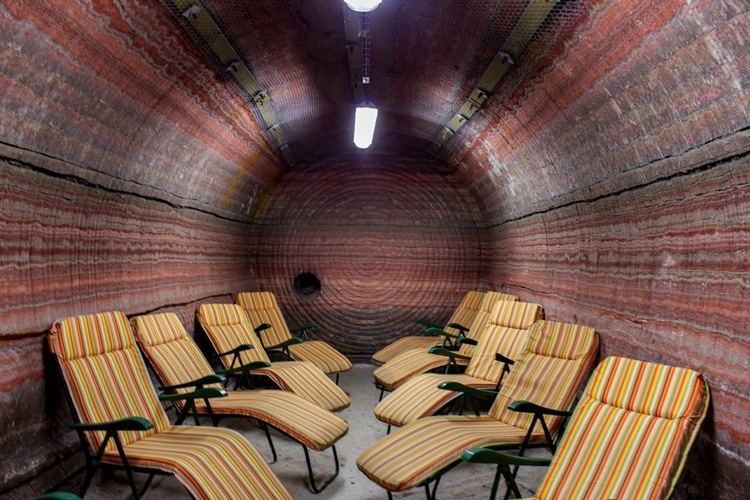 | ||
Speleotherapy (Greek σπήλαιον spḗlaion "cave") is the respiratory therapy involving breathing of the mineral infused air of a salt mine. Salt pipes are based on this therapy, and the therapy uses this same salt.
Contents
There are records of miners in Roman and medieval times showing improvements in their breathing and in their long term breathing endurance, but no one outside of some Olympic Athletes took much notice.
Efficacy
A 2009 Cochrane summary concluded that there is insufficient evidence to determine whether salt therapy in treating asthma is effective and that more research is needed; particularly randomized controlled trials.
Salt mines and caves
These natural deposits of mineral halite are derived from evaporated ancient lakes and seas. The unrefined rock salt, primarily sodium chloride, also includes varying concentrations of other mineral salts such as calcium and magnesium, manganese and sulfates which have additional therapeutic properties, depending on the source.
The special characteristics of the micro-climate of a salt mine include stable air temperature, humidity and lack of airborne pollutants such as pollens, and are unique to each mine. At depth the air pressure is also significantly higher than above ground which has been found to benefit sufferers of respiratory diseases in studies conducted at the Dead Sea, which is below sea level.
There are records of improvements in the breathing of miners in Roman and medieval times. Feliks Boczkowski – a physician at the Polish salt mine at Wieliczka – wrote in 1843 that the miners there did not suffer from lung diseases and his successor set up a spa based upon these observations. Modern use of this therapy started in Germany when Karl Hermann Spannagel noticed improvement in the health of his patients after they hid in the Kluterthöhle karst cave to escape heavy bombing. It is now practised in places such as Bystrianska in Slovakia, Wieliczka in Poland, Solotvyno in Ukraine and many other East European countries.
Halogenerators
Halogenerators are used to simulate the salted atmosphere of salt mines. These highly developed machines crush rock salt into dry micrometre-sized particles, ionize the particles, and release them into the air. Salt particles of sizes 0.1–2.5 micrometres are able to escape the natural defences of the upper airways and travel deep into the lung to the level of the alveoli. Typically used in a small room with floors and walls lined with rocksalt, known as artificial salt room.
Salt lamps are another method of salt therapy. A large crystal of natural salt is hollowed out and heated with a tealight or lightbulb. The crystals give off a glow in various colours of pink, orange, red or purple according to the minerals present.
Home salt therapy
Special home saline therapy devices were developed with the scope of making salt therapy easily available at home, replicating the seashore or speleotherapy aerosol. Hand-held devices and ultrasonic salinizers use rock salt to create the microscopic breathable particles of salt. The hand-held salt inhaler uses dry rock salt and can deliver the salt aerosol by breathing through the mouth and exhaling through the nose, offering 1–2 hours of daily exposure. The ultrasonic salinizer uses saline solution, made with natural rock salt, to create the salt aerosol. These salt particles are released into the indoor air and freely breathed during the night, offering 7–8 hours daily exposure, especially for chronic respiratory diseases.
Salt-water aerosol
Breathing an aerosol of hypertonic salt water (3–7% NaCl) has been found effective as a treatment for the heavy buildup of mucus typical of cystic fibrosis. The benefits of this were first noticed by sufferers who regularly surfed in Australia and so were exposed to the natural aerosol of the salt spray.
The use of saline solution delivered by a nebulizer to treat bronchiolitis in children has also been systematically reviewed. The conclusion was that, "Current evidence suggests nebulized 3% saline may significantly reduce the length of hospital stay and improve the clinical severity score in infants with acute viral bronchiolitis."
